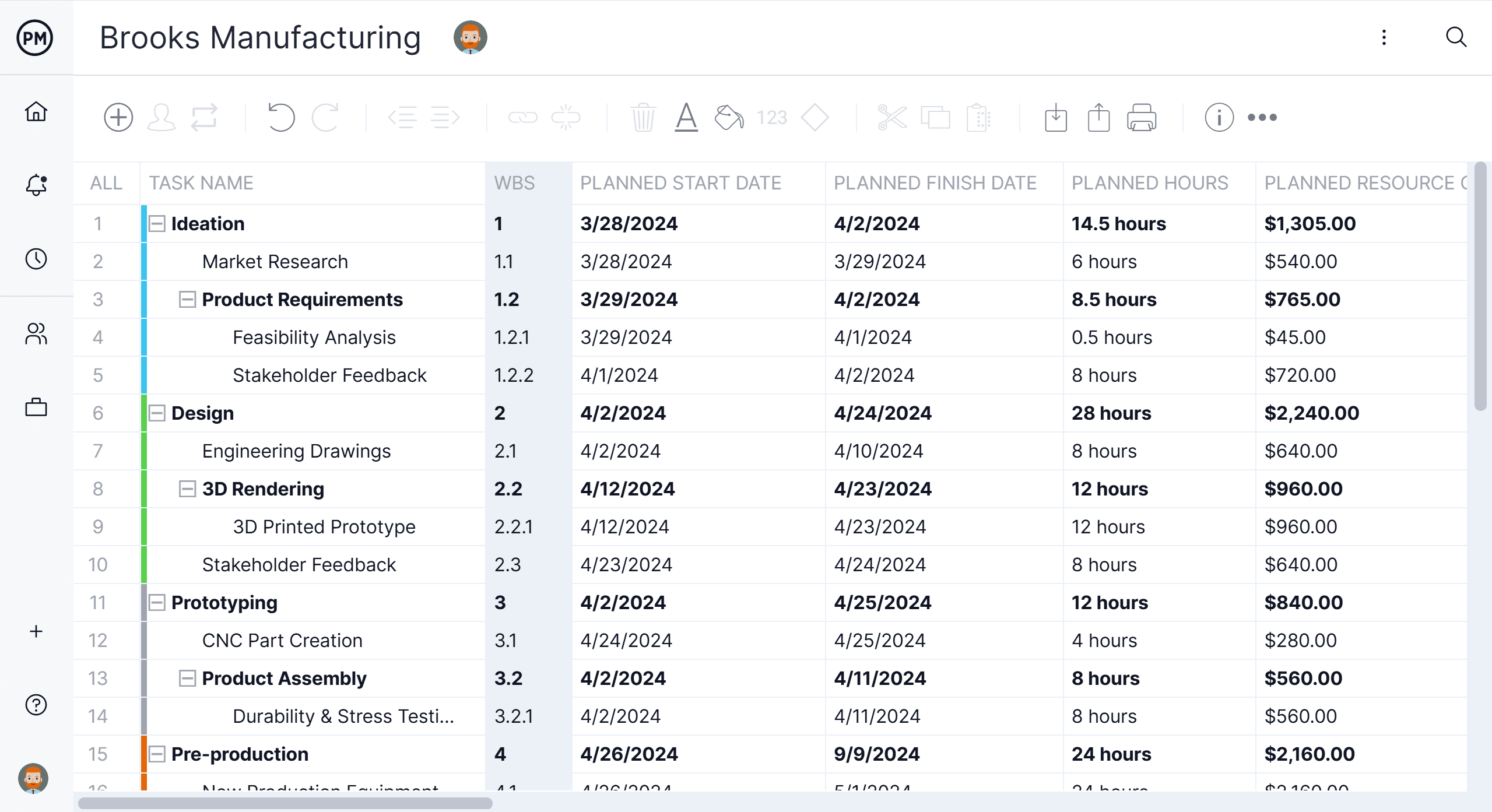- What Is a Work Breakdown Structure (WBS)?
- Why Use a WBS In Project Management?
- Work Breakdown Structure Example
- Types of WBS
- WBS Elements
- How to Create a Work Breakdown Structure In Six Steps
- WBS Software
- Must-Have Features of WBS Software
- How to Create a WBS in ProjectManager
- Work Breakdown Structure Template
- When to Use a WBS?
- Work Breakdown Structure Best Practices
What Is a Work Breakdown Structure (WBS)?
A work breakdown structure (WBS) is a visual, hierarchical and deliverable-oriented deconstruction of a project. It is a helpful diagram for project managers because it allows them to break down their project scope and visualize all the tasks required to complete their projects.
All the steps of project work are outlined in the work breakdown structure chart, which makes it an essential project planning tool. The final project deliverable, as well as the tasks and work packages associated with it rest on top of the WBS diagram, and the WBS levels below subdivide the project scope to indicate the tasks, deliverables and work packages that are needed to complete the project from start to finish.
Project managers make use of project management software to lay out and execute a work breakdown structure. When used in combination with a Gantt chart that incorporates WBS levels and task hierarchies, project management software can be especially effective for planning, scheduling and executing projects.
ProjectManager is an online work management software with industry-leading project management tools like Gantt charts, kanban boards, sheets and more. Plan using WBS levels in our tool, then execute with your team via easy-to-use kanban boards and task lists. Try it for free today.
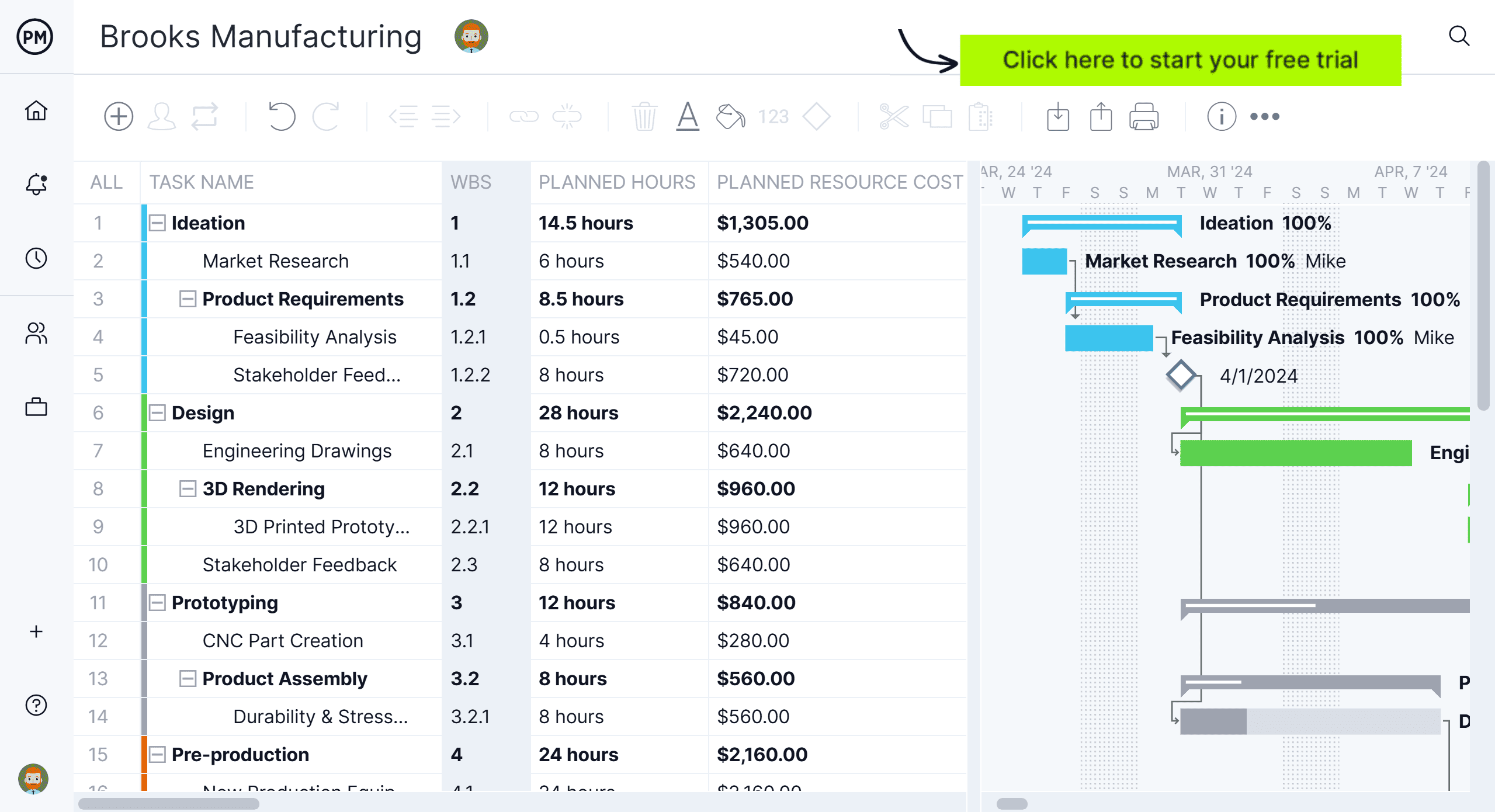
ProjectManager’s online Gantt charts feature a column for the WBS code—learn more
Why Use a WBS In Project Management?
Making a WBS is the first step in developing a project schedule. It defines all the work that needs to be completed (and in what order) to achieve the project goals and objectives. By visualizing your project in this manner, you can understand your project scope, and allocate resources for all your project tasks.
A well-constructed work breakdown structure helps with important project management process groups and knowledge areas such as:
- Project Planning, Project Scheduling and Project Budgeting
- Risk Management, Resource Management, Task Management and Team Management
In addition, a WBS helps avoid common project management issues such as missed deadlines, scope creep and cost overrun, among others.
In other words, a work breakdown structure serves as your map through complicated projects. Your project scope may include several phases or smaller sub-projects—and even those sub-projects can be broken down into tasks, deliverables, and work packages! Your WBS can help you manage those items, and gain clarity into the details needed to accomplish every aspect of your project scope.
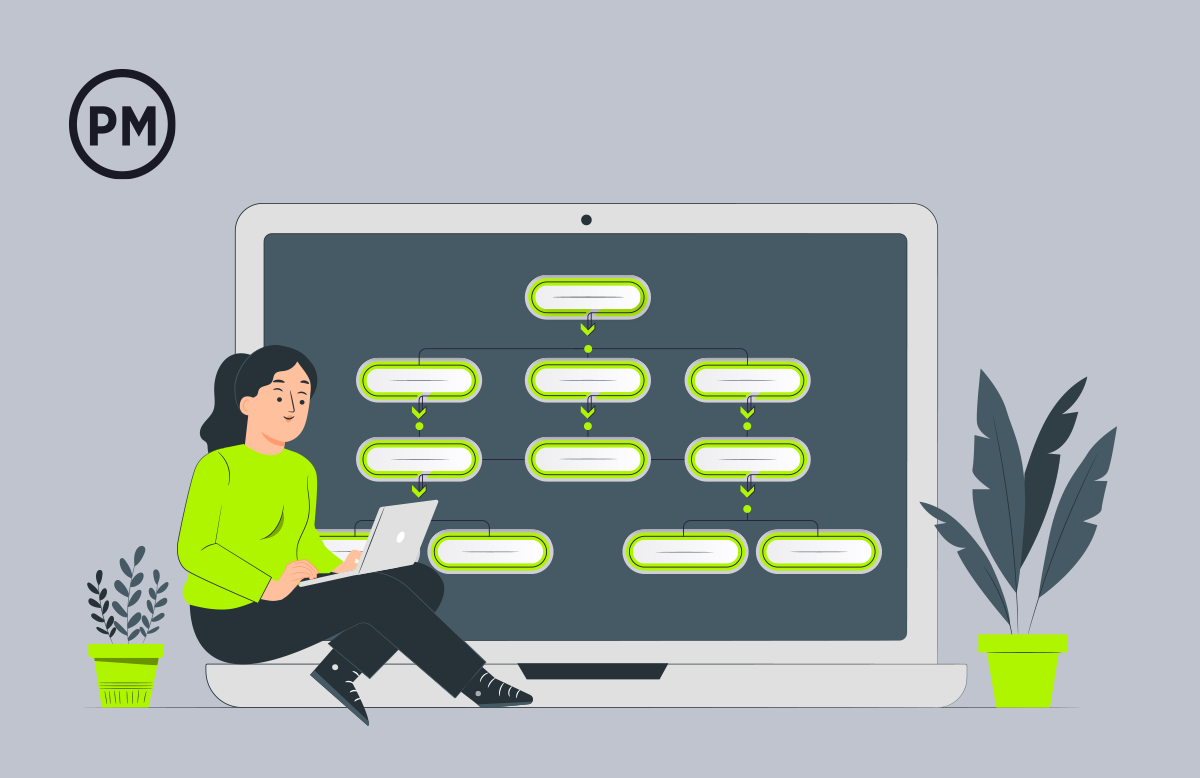
Get your free
WBS Template
Use this free WBS Template for Excel to manage your projects better.
Work Breakdown Structure Example
Now that we’ve gone through the definition of a WBS and learned why they are a great project management tool, let’s take a look at a work breakdown structure example.
For our WBS example, we’ll be creating a work breakdown structure to lay down the work plan for a commercial building construction project. This is potentially a complex project, but a WBS chart will take that complexity and boil the project scope down to simpler tasks to make the project manageable.
Study the phase-based work breakdown structure example of a construction project below:
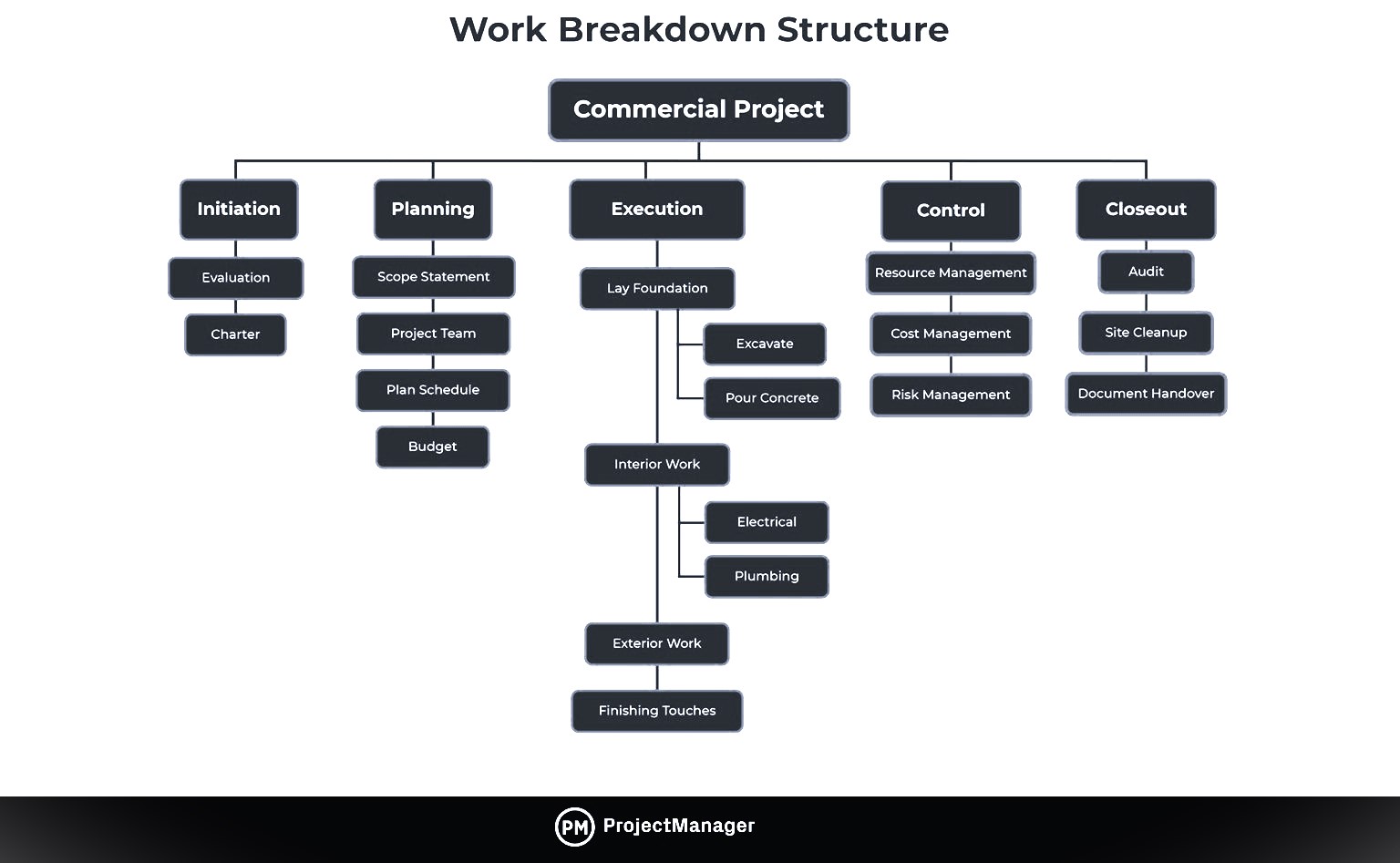
At the top of the work breakdown structure is your final deliverable (in this instance, the construction project). Immediately beneath that is the next WBS level, which are the main project phases required to complete the project. The third and lowest level shows work packages. Most WBS charts have 3 levels, but you can add more depending on the complexity of your projects.
Each of those five project phases—initiation, planning, execution, control and closeout, also act as control accounts and branch off the main deliverable at the top. Once decided, they are then broken down into a series of deliverables. For example, the initiation phase includes site evaluation work and creating the project charter.
You’ll also need a work package to go with each of those project deliverables. In the execution phase of our construction example, we can look at the interior work deliverable. That deliverable is divided into two work packages, which are installing the plumbing and setting up the electricity.
The WBS, when created as thoroughly as possible, is the roadmap to guide you to the completion of what would seem to be a very complicated project scope. However, when broken down with a WBS, project planning, scheduling and resource planning suddenly become much more manageable.
Types of WBS
There are two main types of WBS: deliverable-based, and phase-based. They depend on whether you want to divide your project in terms of time or scope.
Deliverable-Based Work Breakdown Structure
A deliverable-based WBS first breaks down the project into all the major areas of the project scope as control accounts and then divides those into project deliverables and work packages.
Here’s an example of a deliverable-based WBS that’s taken from our free work breakdown structure template. Download the template today to practice building your own work breakdown structure in Excel.
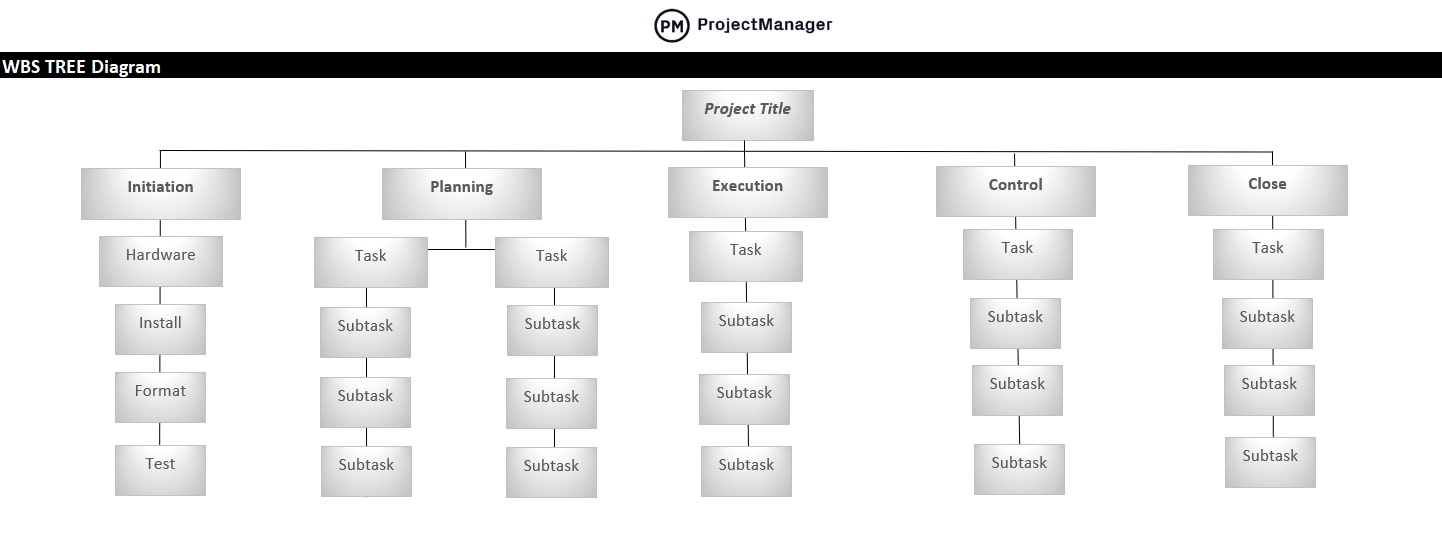
A deliverable-based WBS example showing control accounts, work packages and tasks.
Phase-Based Work Breakdown Structure
The phase-based WBS displays the final deliverable on top, with the WBS levels below showing the five phases of a project (initiation, planning, execution, control and closeout). Just as in the deliverable-based WBS, the project phases are divided into project deliverables and work packages. Our previous graphic in the “Work Breakdown Structure Example” section contained a phase-based WBS example.
Types of WBS Charts
Once you’ve chosen a deliverable-based or phase-based WBS, you can also choose between different types of WBS diagrams. Let’s take a look at the main types of work breakdown structure charts.
Work Breakdown Structure List: Also known as an outline view, this is a list of work packages, tasks and deliverables. It’s probably the simplest method to make a WBS, which is sometimes all you need.
Work Breakdown Structure Tree Diagram: The most commonly seen version, the tree structure depiction of a WBS is an organizational chart that has all the same WBS elements of the list (phases, deliverables, tasks and work packages) but represents the workflow or progress as defined by a diagrammatic representation.
Work Breakdown Structure Gantt Chart: A Gantt chart is both a spreadsheet and a timeline. The Gantt chart is a WBS that can do more than a static task list or tree diagram. With a dynamic Gantt chart, you can link dependencies, set milestones, even set a baseline. This is the most common version in project management software.
Build a work breakdown structure Gantt chart diagram in ProjectManager in just a matter of minutes. Get started for free today.
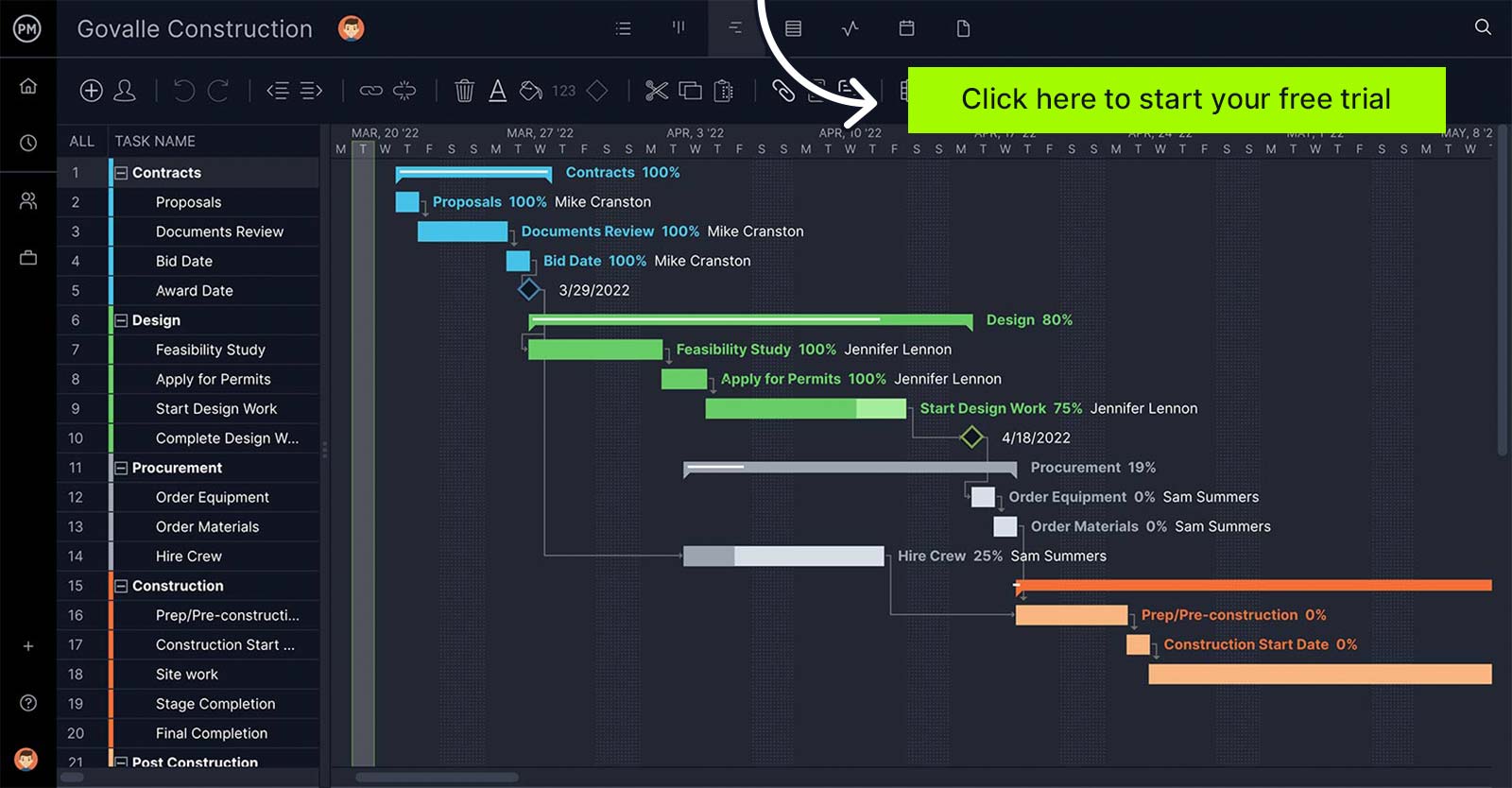
A Gantt chart with WBS codes in ProjectManager. Learn more
WBS Elements
A typical project work breakdown structure is made up of several key components. We’ll use our WBS example above to identify each of the main WBS elements.
- WBS Dictionary: A WBS dictionary is a document that defines the various WBS elements. It’s an important component of a WBS because it allows the project participants and stakeholders to understand the work breakdown structure terminology with more clarity.
- WBS Levels: The WBS levels are what determines the hierarchy of a WBS element. Most work breakdown structures have 3 levels that represent the project’s main deliverable, control accounts, project deliverables and work packages.
- Control Accounts: Control accounts are used to group work packages and measure their status. They’re used to control areas of your project scope. In our example, the execution project phase could be a control account because it has several deliverables and work packages associated with it.
- Project Deliverables: Project deliverables are the desired outcome of project tasks and work packages. In our WBS example, we can observe some examples of project deliverables such as the project budget or interior work. Both of them are the result of smaller tasks and work packages.
- Work Packages: As defined by the project management institute (PMI) in its project management body of knowledge book (PMBOK) a work package is the “lowest level of the WBS”. That’s because a work package is a group of related tasks that are small enough to be assigned to a team member or department. As a project manager, you can estimate costs and duration of these work packages, which makes them an essential WBS element.
- Tasks: Your tasks make up your work packages and therefore, your project scope. A WBS will help you define each task requirements, status, description, task owner, dependencies, and duration.
If you prefer a visual and verbal explanation of this information on work breakdown structures, watch this video.
How to Create a Work Breakdown Structure In Six Steps
To create a WBS for your project, you’ll need information from other project management documents. Here are six simple steps to create a work breakdown structure.
1. Define the Project Scope, Goals and Objectives
Your project goals and objectives set the rules for defining your project scope. Your project scope, team members, goals and objectives should be documented on your project charter.
2. Identify Project Phases & Control Accounts
The next level down is the project phases: break the larger project scope statement into a series of phases that will take it from conception to completion. You can also create control accounts, which are task categories for different work areas you want to keep track of.
3. List Your Project Deliverables
What are your project deliverables? List them all and note the work needed for those project deliverables to be deemed successfully delivered (sub-deliverables, work packages, resources, participants, etc.)
4. Set WBS Levels
The WBS levels are what make a work breakdown structure a “hierarchical deconstruction of your project scope”, as defined by the project management institute in its project management body of knowledge book (PMBOK). You’ll need to start at the final project deliverable and think about all the deliverables and work packages needed to get there from the start.
5. Create Work Packages
Take your deliverables from above and break them down into every single task and subtask that is necessary to deliver them. Group those into work packages.
6. Choose Task Owners
With the tasks now laid out, assign them to your project team. Give each team member the work management tools, resources and authority they need to get the job done.
WBS Software
Work breakdown structure software is used to outline a project’s final deliverable and define the phases that are necessary to achieve it.
Software facilitates the process in several different ways. Some use a network diagram and others use a Gantt chart. All of them, however, are a visual representation of the project, literally breaking down the various stages and substages needed to assemble the final project deliverable.
Must-Have Features of WBS Software
There are many types of work breakdown structure software available, so when you’re looking for one to help you plan your project, be sure it offers these features:
Break Tasks Down
Deliverables are important to define, as are the tasks that get you there—but most tasks require being broken down further in order to complete them. That’s where subtasks come in. They’re part of a more complex task, and you want that feature in your WBS software.
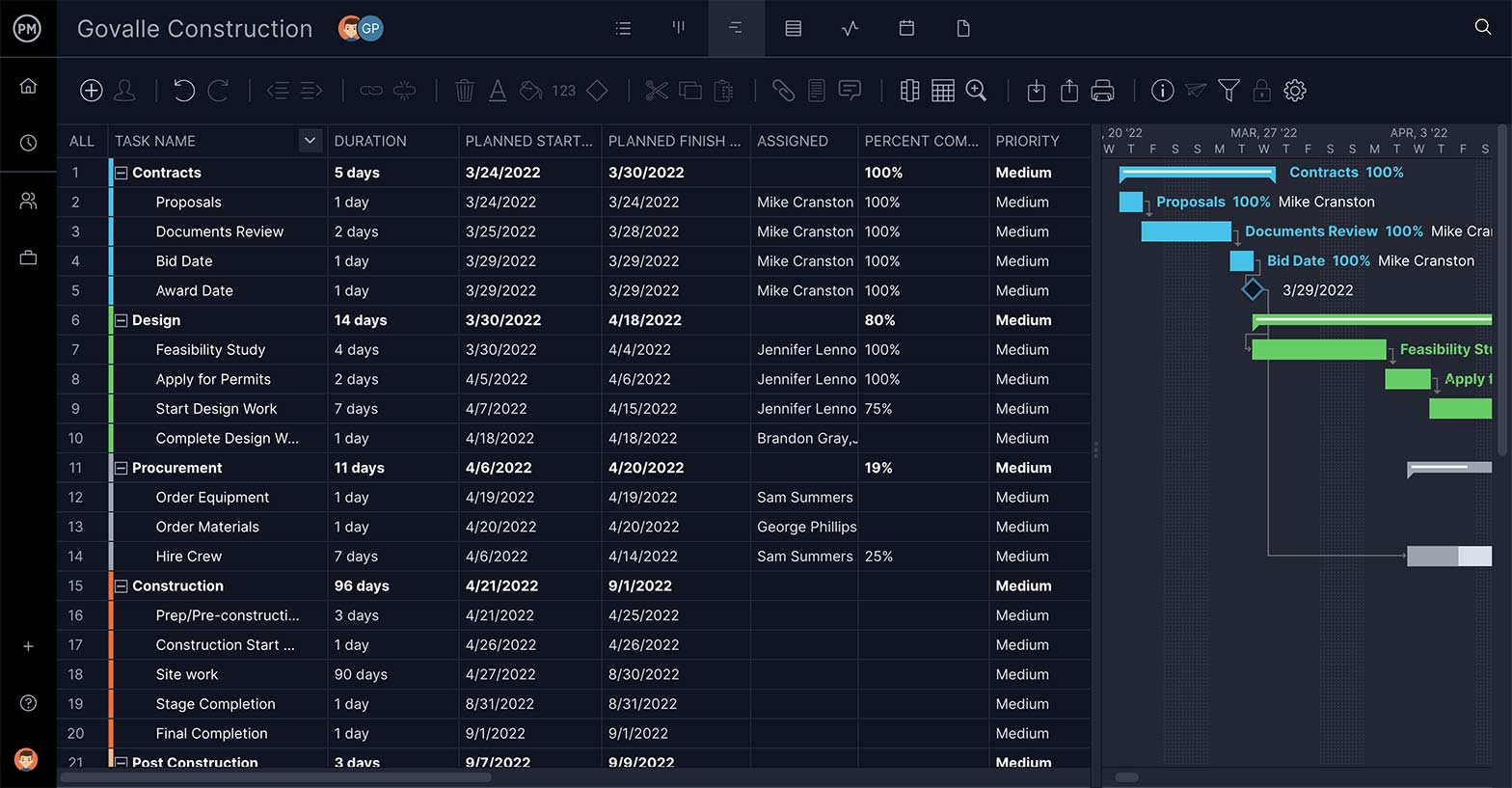
Link Dependent Tasks
Not all tasks are the same. Some can’t start or stop until another has started or stopped. These dependent tasks can create a bottleneck later in the project’s execution phase, unless you identify them early. Having a task dependency feature is essential.

Set Task’s Priority and Duration
The point of WBS software is to build a feasible schedule. Therefore, you need features that feed into this process by defining the priority of the task, so you know which phase it goes with; as well as describing the task and estimating how long it will take to complete.
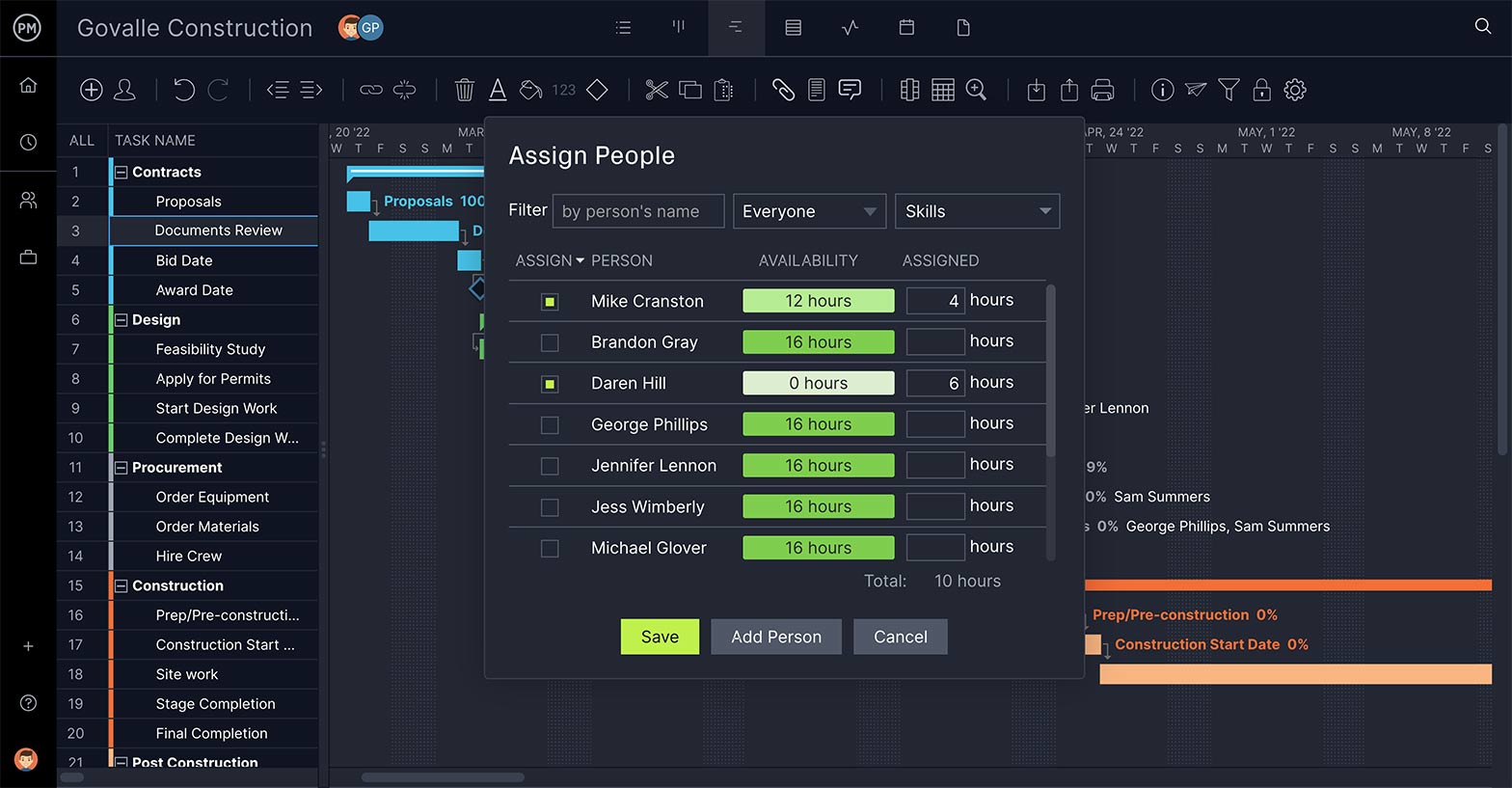
Keep Your Team Working
The WBS sets up your tasks and deliverables, but once the project is in the execution stage, it’s key that you have a way to allocate resources to your team to keep the tasks moving as planned. That includes a feature to make sure their workload is balanced.
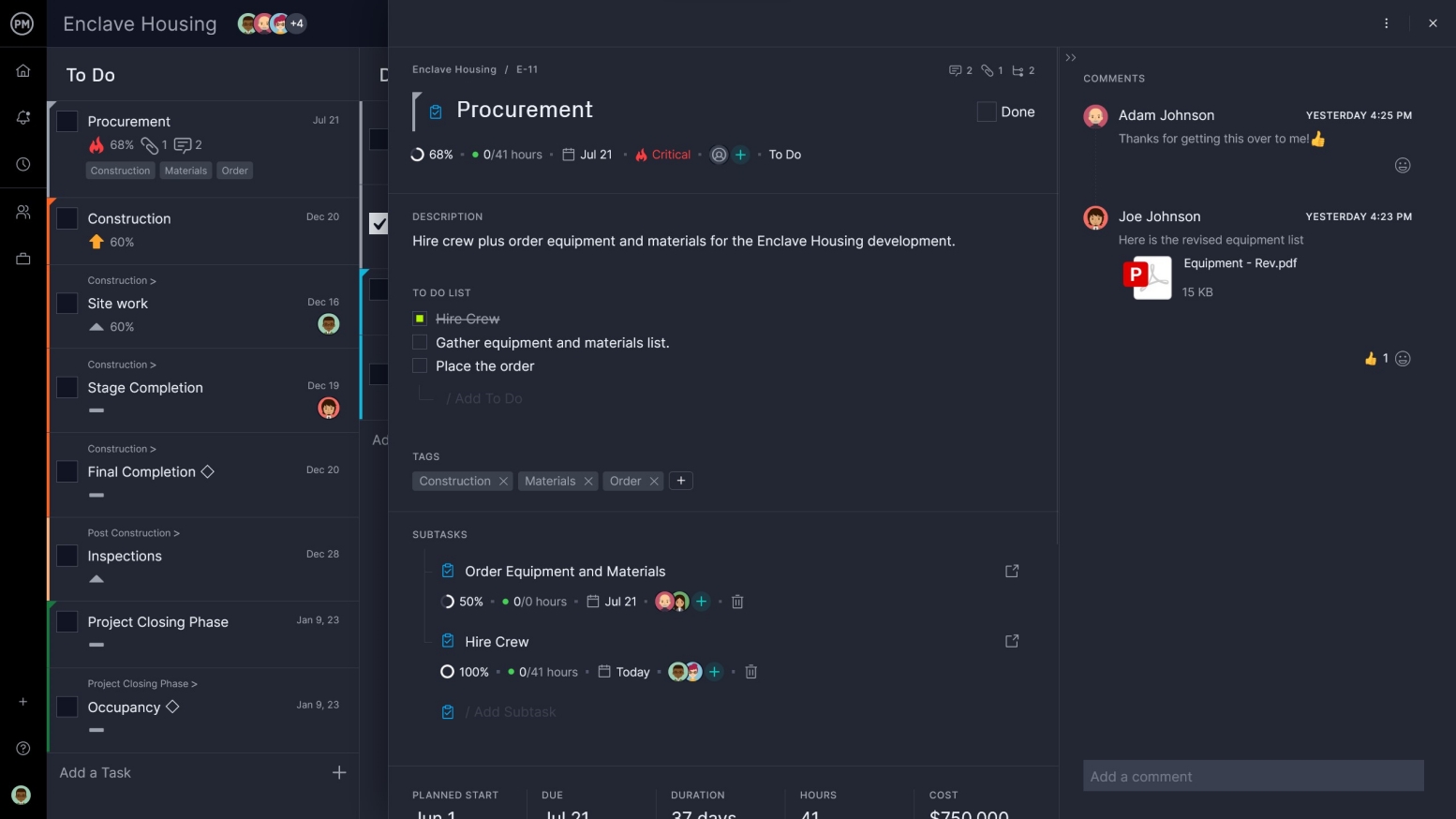
Get a High-Level View
Being able to monitor your progress is what keeps your project on schedule. A WBS software sets up the plan and you must have features to maintain it throughout all the phases of the project. Dashboards can give you a view of the landscape across several metrics.

Make Better Decisions
As you move from the planning to the execution stage, you’ll need a reporting feature that can deliver critical project data on progress and performance. This information will feed your decision-making and help you steer the project to a successful conclusion.
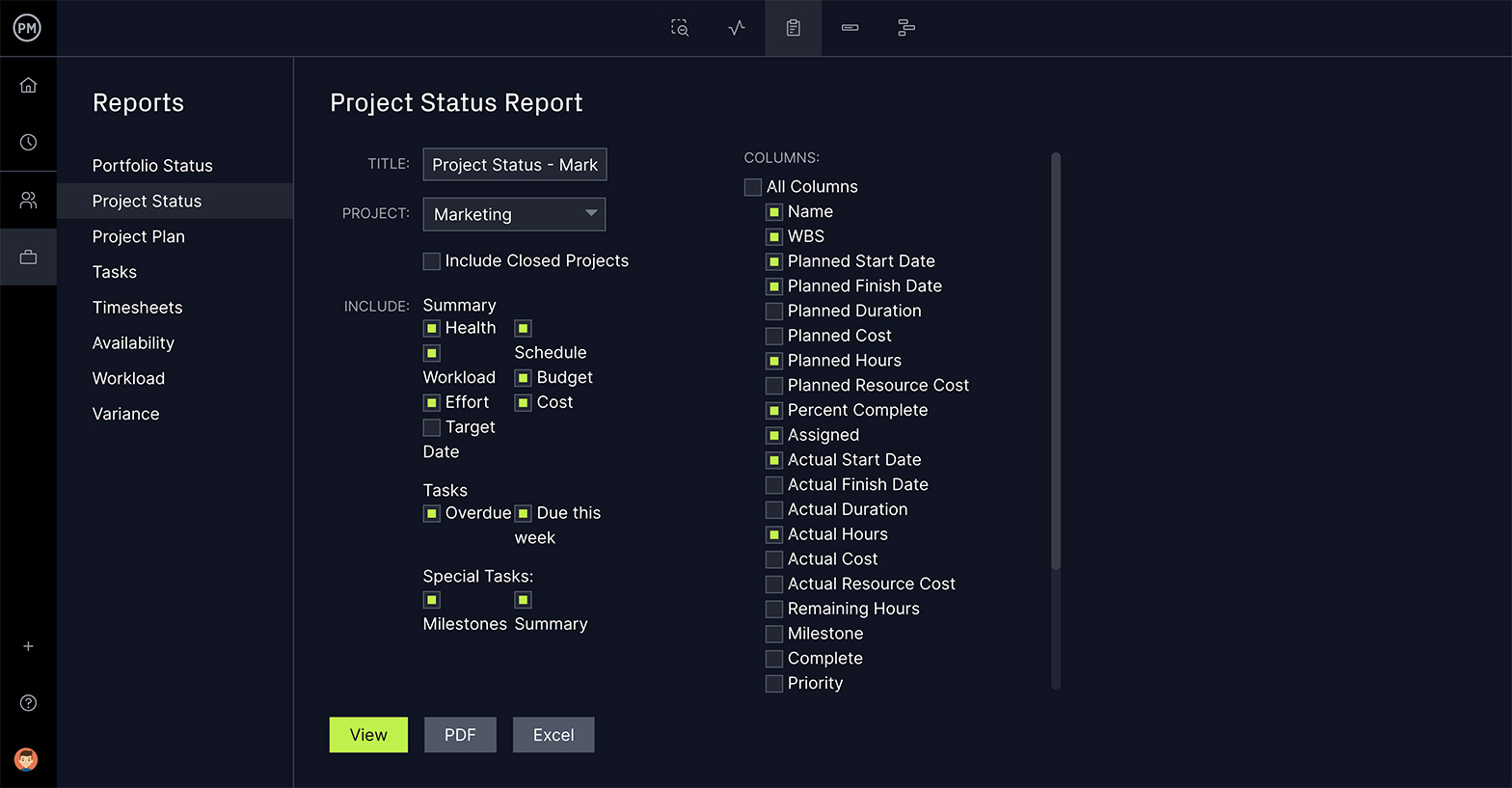
How to Create a WBS in ProjectManager
The purpose of work breakdown structure software in project management is to organize and define the scope of your project. Using ProjectManager’s online Gantt charts to build your WBS is not only more efficient, it dovetails into every other aspect of your project, because of our robust suite of project management features.
Here’s a quick summary of how to create a WBS using a Gantt chart. Sign up for a free trial of our software and follow along!
1. Identify Project Deliverables
There are 5 stages in the project life cycle, initiation, planning, execution, monitoring and closure. Each of them produces deliverables that are required to produce the final deliverable, which is the completion of your project.
Identify the phases in your project to create more than a mere task list. Set them apart with our milestone feature on the Gantt chart tool. They can also be color coded to better differentiate the phases.
2. List Subtasks, Describe Tasks & Set Task Owner
Subtasks are part of a larger, more complex task. In this case, your WBS work packages are perfect for this feature. Add summary tasks or work packages above the related tasks, which can be your project phases or project deliverables, depending on your WBS type preference and indent them. The image below shows our WBS example represented on a Gantt chart, showing the project phases and work packages associated with them.
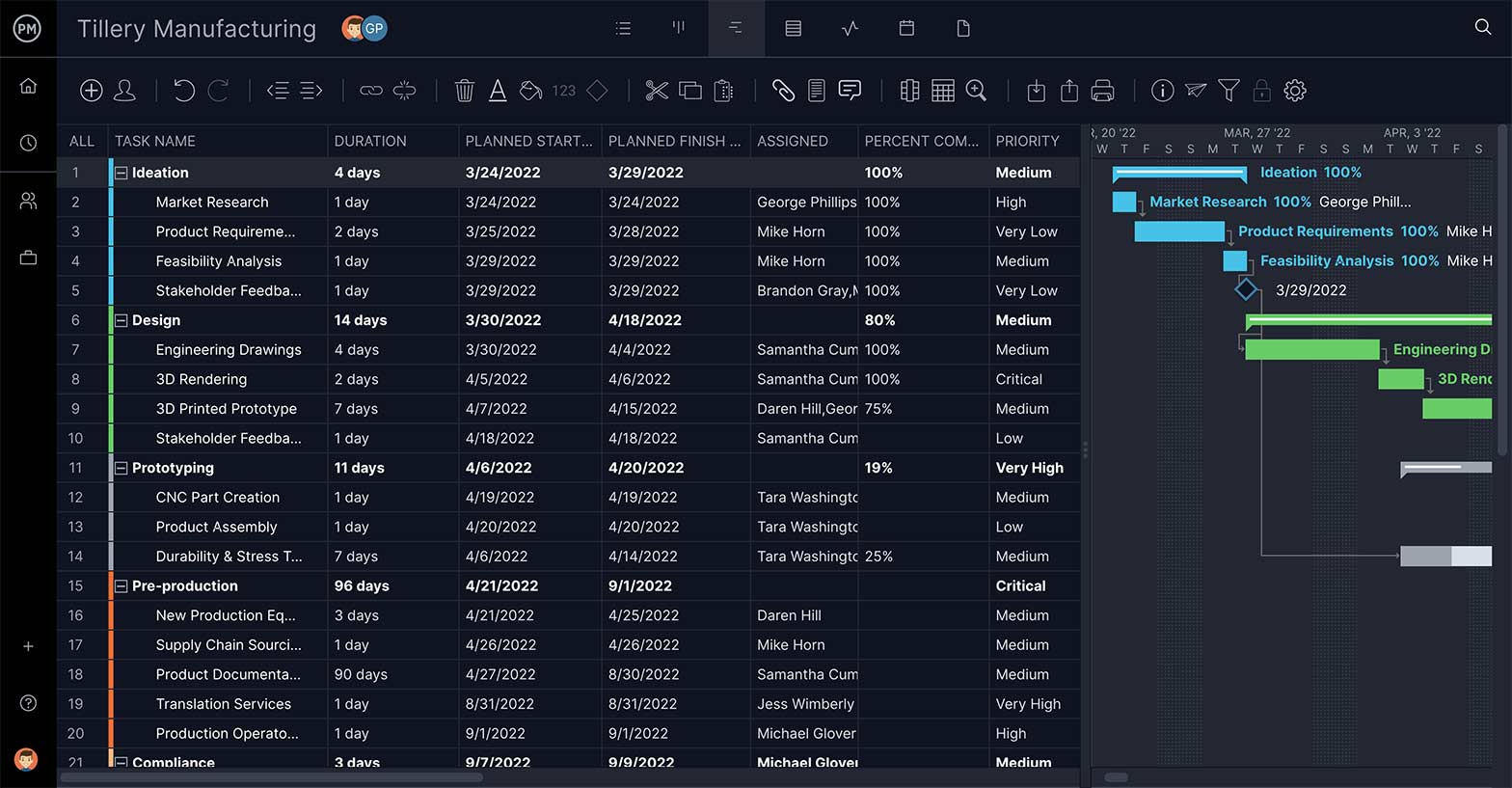
3. Link Dependencies
Task dependencies are tasks that cannot start until another is finished or started. Link tasks that are dependent on one another by dragging one to the other. We link all four types of task dependencies. By identifying these tasks at this stage, you’ll avoid bottlenecks during execution.
4. Set Resources & Costs
Resources are anything that you need to complete the project phases, deliverables and work packages. They range from the people on your team to materials, supplies and equipment. Your WBS allows you to break down your project scope into work packages so that you can estimate resources and costs.
5. Add Start & End Dates & Estimated Completion
Every task has a start and an end date. Add the date when the task needs to start in the planned start date column and when it should be completed in the planned finished date. There’s also an estimated completion column for the amount of time you plan for the task to take.
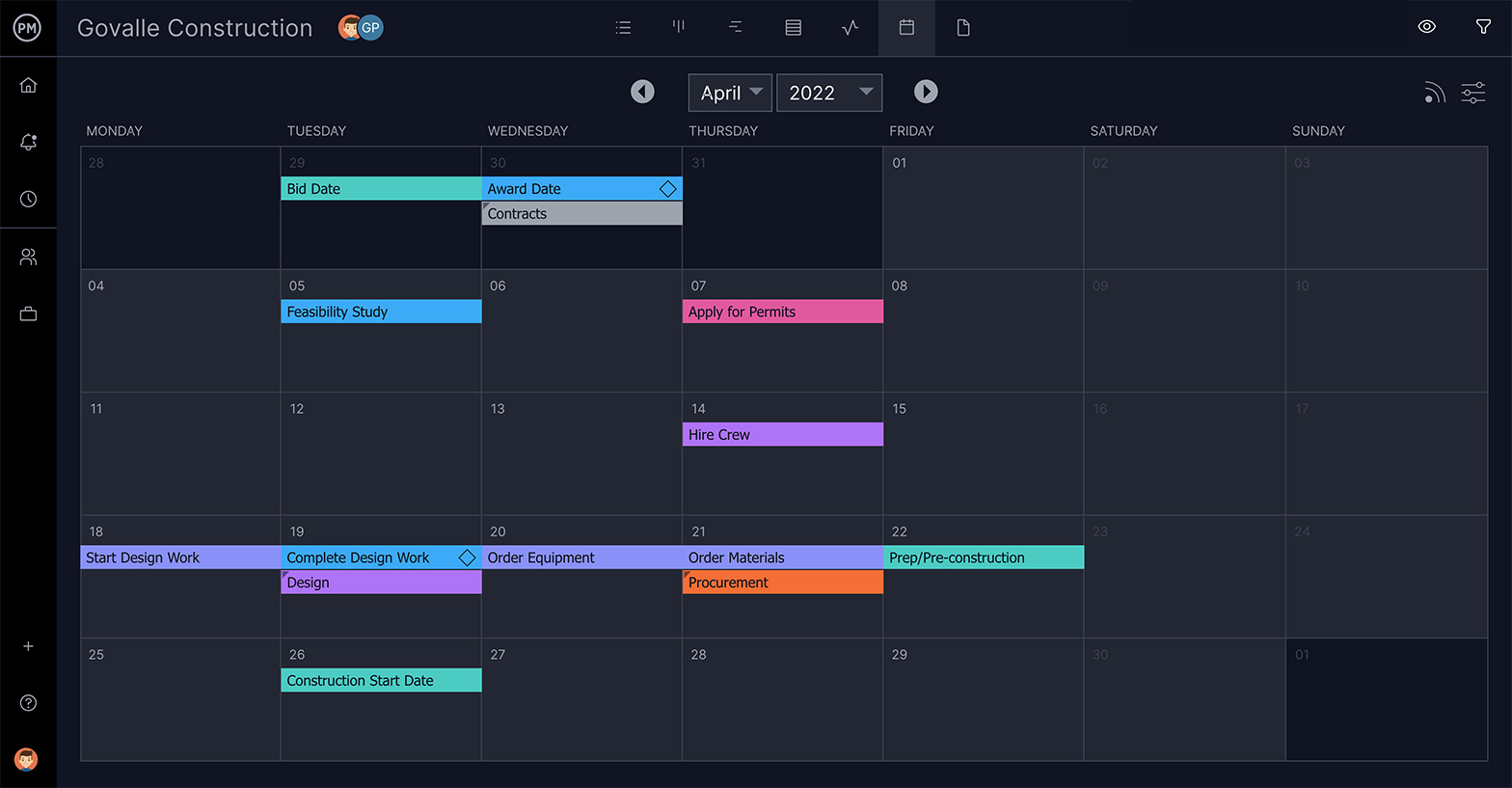
6. Track Status of Control Accounts & Work Packages
Tracking is how to know if a project is performing as planned. That’s why a WBS has control accounts and work packages. When speaking of tasks, tracking tells you multiple things: logged hours, costs, priority, new communications, the percentage complete and how its actual progress compares to your planned progress.
7. Write Notes
Having a section in which to jot down notes is always advisable. While the WBS is thorough, there might be something you need to address that doesn’t fit into its rigid structure.
8. Generate Reports
Project reports pull data from the project to illuminate its progress, overall health, costs and more. Generate a report on your WBS by using our reporting tool. Our reports summarize your project data and allow you to filter the results to show just want you want. Reports can also be shared with stakeholders.

Work Breakdown Structure Template
If you’re not ready to take the plunge and use ProjectManager’s work breakdown structure software, but you’re still interested in seeing how using this tool can help you construct a sturdier plan for your next project, don’t worry. We have an intermediate step you can take.
We also have a library of free project management templates, including a free WBS template, to get you started off right.
If you decide to try out our project management software, we offer a free 30-day trial. You can upload the project work breakdown structure template into ProjectManager, and it automatically creates a new project in our software. Now you can use that template to plan, schedule, monitor and report on your project.
Because our software is cloud-based, all your data is collected and displayed in real time. This makes us different from on-premises project management software like Microsoft Project. We take your WBS and make it more dynamic with our online planning tools.
When to Use a WBS?
There are many ways in which you can use a work breakdown structure to help you manage work. Here are three common examples of how to use a WBS for different purposes.
Scope of Work
A scope of work is a comprehensive document that explains your project scope, which is all the work to be performed. A WBS is the perfect tool to break down the scope of a project into work packages that are easier to control. On top of that, a work breakdown structure allows you to easily identify milestones, deliverables and phases.
Statement of Work
A statement of work is a legally binding document between a client and the organization who’s responsible for executing a project. It details project management aspects such as the timeline, deliverables, requirements of the project.
Work Order
A work order is similar to a statement of work, but it’s main purpose is to show the costs associated with each task. A WBS is essential for an accurate cost estimation.
Work Breakdown Structure Best Practices
As you’re working on your WBS it is helpful to maintain some best practices. Here are some things to keep in mind.
- 100% Rule: This is the most important work management principle to construct a WBS. It consists in including 100% of the work defined by the project scope, which is divided into WBS levels that contain control accounts, project deliverables, work packages and tasks. This rule applies to all the levels of the WBS, so the sum of the work at a lower WBS level must equal the 100% of the work represented by the WBS level above without exception.
- Use Nouns: WBS is about deliverables and the tasks that will lead to your final deliverable. Therefore, you’re dealing more on the what than the how. Verbs are great for action, and should be used in your descriptions, but for clarity, stick to nouns for each of the steps in your WBS.
- Be Thorough: For a WBS to do its job, there must be no holes. Everything is important if it’s part of the course that leads to your final deliverable. To manage that schedule, you need a complete listing of every task, big and small, that takes you there.
- Keep Tasks Mutually Exclusive: This simply means that there’s no reason to break out individual tasks for work that is already part of another task. If the work is covered in a task because it goes together with that task, then you don’t need to make it a separate task.
- Go Just Deep Enough: You can get crazy with subtasks on your WBS. The WBS has to be detailed, but not so deep that it becomes confusing. Ideally, think maybe three or five at most levels.
All our tools are geared to making your project more efficient and effective. See for yourself by starting your free 30-day trial of our software.
Work Breakdown Structure Resources
Templates
Start your free 30-day trial
Deliver faster, collaborate better, innovate more effectively — without the high prices and months-long implementation and extensive training required by other products.
Start free trial